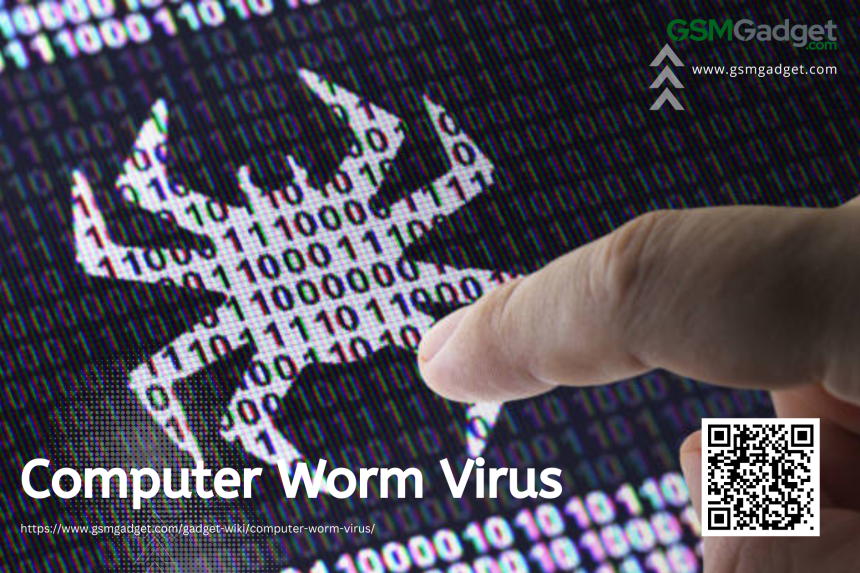A computer worm virus is a type of self-replicating malware that spreads autonomously across networks by taking advantage of vulnerabilities, without requiring human intervention or a host file. It presents a serious threat to digital infrastructure by using up bandwidth, overwhelming servers, and possibly delivering other harmful payloads. The harm caused by worms can vary from decreased system efficiency to serious data breaches. It is crucial for both individuals and organizations to understand how computer worm viruses work and the risks they pose in order to safeguard sensitive information and uphold cybersecurity in the interconnected world of digital technology.
Specification Table of Computer Worm Virus
| Attribute | Description |
| Name | Computer Worm Virus |
| Type | Malware |
| Category | Worm |
| Propagation Method | Self-replicating, spreads through networks, email attachments, software vulnerabilities, or social engineering |
| Target Systems | Varies (Windows, macOS, Linux, etc.) |
| Payload | Data theft, system damage, backdoor creation, DDoS attacks, etc. |
| Symptoms | Slow system performance, unexpected system behavior, loss of files, increased network traffic |
| Infection Vector | Exploits, file sharing, removable drives, etc. |
| Detection | Antivirus software, network monitoring tools, system behavior analysis |
| Removal | Antivirus software, malware removal tools, system restore, reformatting infected drives |
| Prevention | Regular updates, firewalls, user education, avoiding suspicious links/attachments, using security software |
| Famous Examples | ILOVEYOU, Conficker, Stuxnet, Slammer |
| Release Date | Varies by specific worm |
| Authors | Varies by specific worm |
| Mode of Discovery | Antivirus research, user reports, system monitoring |
| Impact | Can range from minor annoyance to significant economic and infrastructure damage |
| Mitigation Strategies | Patch management, network segmentation, intrusion detection systems, regular backups |
| Legal Consequences | Criminal charges for creators/distributors, depending on jurisdiction |
History of Computer Worms Virus
The history of computer worms can be traced back to the theoretical concepts of John von Neumann in the 1940s. However, it was not until the creation of the benign Creeper worm in 1971 that the potential of self-replicating programs began to materialize. The Morris worm emerged in 1988 as the first to cause significant real-world damage, exploiting Unix system vulnerabilities and resulting in the first felony conviction under the Computer Fraud and Abuse Act. Since then, computer worms have become increasingly sophisticated, with incidents like the ILOVEYOU worm in 2000, SQL Slammer in 2003, and Conficker in 2008, each causing widespread damage and prompting enhancements in cybersecurity defenses. These worms, which do not require a host program to spread and can independently replicate to exploit network vulnerabilities, have highlighted the critical need for vigilance and regular software updates to protect against their evolving threats.
How Computer Worms Virus Spread
Computer worms are a form of malware that self-replicate in order to propagate through networks, taking advantage of security weaknesses without requiring human intervention. These harmful programs have the potential to cause substantial harm by utilizing bandwidth, erasing files, and introducing additional malware. It is essential to comprehend their methods of spreading in order to implement effective cybersecurity strategies.
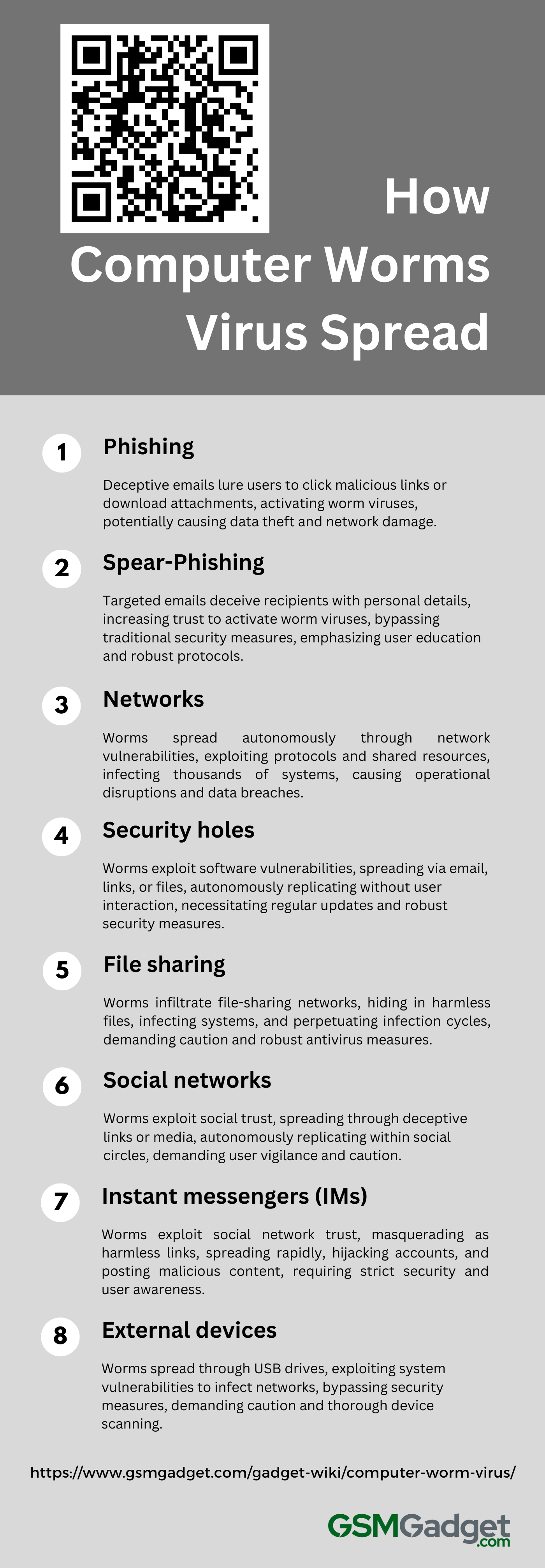
1. Phishing
Phishing is a common and deceptive method used by computer worms to infiltrate and spread across networks and devices. These attacks typically involve fraudulent emails or messages from seemingly legitimate sources, which lure users into clicking on malicious links or downloading compromised attachments. Once a user is tricked into engaging with these harmful elements, the worm virus activates, replicates, and disseminates itself to other contacts, potentially installing additional malware. This can result in data theft, unauthorized access, and extensive network damage. The effectiveness of phishing is largely due to social engineering tactics that exploit human psychology, such as creating a sense of urgency or feigning authority, to trick users into undermining their own security. Recognizing and understanding phishing schemes is essential for preventing worm outbreaks and safeguarding cybersecurity.
2. Spear-Phishing
Spear-phishing is a targeted and sophisticated technique used by cybercriminals to spread computer worm viruses through deceptive emails. These emails are carefully designed to appear as if they are from trusted sources, in order to trick specific individuals or organizations into revealing sensitive information or opening malicious attachments. By including personal information about the victim, attackers build trust and increase the likelihood that the recipient will click on a link or download an attachment, activating the worm virus. Once activated, the virus exploits system vulnerabilities to replicate and spread through networks, potentially leading to unauthorized access, data breaches, and significant operational disruptions. The success of spear-phishing lies in its ability to bypass traditional security measures by exploiting the human element of trust. This highlights the importance of robust cybersecurity protocols and user education to detect and prevent these deceptive attacks.
3. Networks
Computer worms are a highly infectious form of malware that can autonomously spread through networks by exploiting vulnerabilities in network protocols, software flaws, or security loopholes such as unpatched systems and weak passwords. They have the ability to replicate and move between devices using the network’s communication protocols without human intervention. Worms can spread through email attachments, disguise themselves as harmless files, or take advantage of open shared folders and insecure write permissions. The interconnected nature of modern networks allows these worms to quickly infect thousands of systems, causing significant operational disruptions and data breaches. Unlike viruses, worms do not need a host program to replicate, making them a serious threat that can exploit network configuration errors and spread independently.
4. Security holes
Computer worms are a type of malicious software that replicate themselves and spread through networks by taking advantage of security vulnerabilities in software applications or operating systems. These vulnerabilities typically occur when systems are not updated with the latest security patches. Worms are capable of self-executing and multiplying without user interaction, often being transmitted through email attachments, links, or files from untrustworthy sources. Notable examples such as the WannaCry worm used the EternalBlue exploit to target Windows SMB servers and encrypt files, while SQL Slammer rapidly propagated by exploiting vulnerabilities in Microsoft SQL Server and MSDE. To prevent such attacks, it is crucial to implement robust security measures, including regular system updates, strong antivirus programs, and vigilant network monitoring to detect and stop worm activity before it causes significant harm.
5. File sharing
Computer worms, known for their ability to self-replicate and spread, exploit vulnerabilities in file sharing networks. These viruses infiltrate various file-sharing networks, including peer-to-peer platforms, cloud services, and corporate systems, by hiding within seemingly harmless files, such as media or executable files. Once a user downloads or shares an infected file, the worm activates, duplicates, and potentially spreads to other files, perpetuating a cycle of infection. This can result in significant disruptions, data compromise, and system damage, as demonstrated by the Stuxnet worm, which spread through USB devices. To mitigate these risks, it is crucial to use robust antivirus programs, keep software updated, and exercise caution when downloading files, especially from unverified sources, to safeguard network integrity and sensitive information.
6. Social networks
Computer worms exploit the interconnectedness of social networks to spread rapidly, using social engineering to trick users with deceptive links or media content that appear to come from trusted contacts. These worms autonomously replicate and distribute themselves by sending copies to an infected user’s contacts or by posting on various feeds and groups, taking advantage of the trust and rapid sharing capabilities inherent in social circles. They can bypass traditional security measures since they often operate through user consent and exploit specific platform vulnerabilities. To combat this threat, it is essential to exercise caution and remain vigilant when interacting with unexpected content on social networks, as this vigilance is critical in preventing the proliferation of these cunning cyber threats.
7. Instant messengers (IMs)
In the informative and technical field of cybersecurity, computer worms present a significant threat on social networks by exploiting the trust and dense connectivity among users. These worms typically masquerade as harmless links or applications to entice users into clicking or downloading them. Once activated, they can hijack accounts, replicate themselves, and spread the infection to a user’s contacts or by posting malicious content, utilizing social engineering techniques such as appearing as appealing videos or urgent messages. The rapid spread of worms is facilitated by the network’s structure, where a single worm can quickly compromise thousands of systems. As a result, social networks require strict security measures and user awareness to effectively combat these cyber threats.
8. External devices
Computer worms, a type of malware known for their ability to self-replicate, can spread through external devices such as USB flash drives and external hard drives. These worms exploit system vulnerabilities or the autorun feature to execute their malicious code upon connection to a computer. This enables them to integrate into system files or attach themselves to legitimate applications, facilitating their spread to other devices and potentially an entire network. The autonomous manner in which they propagate poses a significant threat, as they can bypass network security measures and infect protected systems. To counter this threat, it is crucial to exercise caution by avoiding the use of suspicious external devices and ensuring that all devices are thoroughly scanned with up-to-date antivirus software before connecting them to any computer system.
Types of Computer Worm Virus
Computer worms are a well-known form of malware that can self-replicate and spread across networks and devices without user intervention. They come in different forms, each with unique propagation methods and characteristics, causing significant disruptions in affected systems. Their ability to self-replicate makes them especially dangerous as they can quickly infect many computers by exploiting vulnerabilities in networked environments.
- Email Worms
- Internet worms
- File-sharing Worms
- Instant Messaging Worms
- IRC Worms
- P2P Worms
- Payload-Carrying Worms
Examples of Computer Worms Virus
Below is a list of well-known computer worm viruses that have had significant impacts over the years.
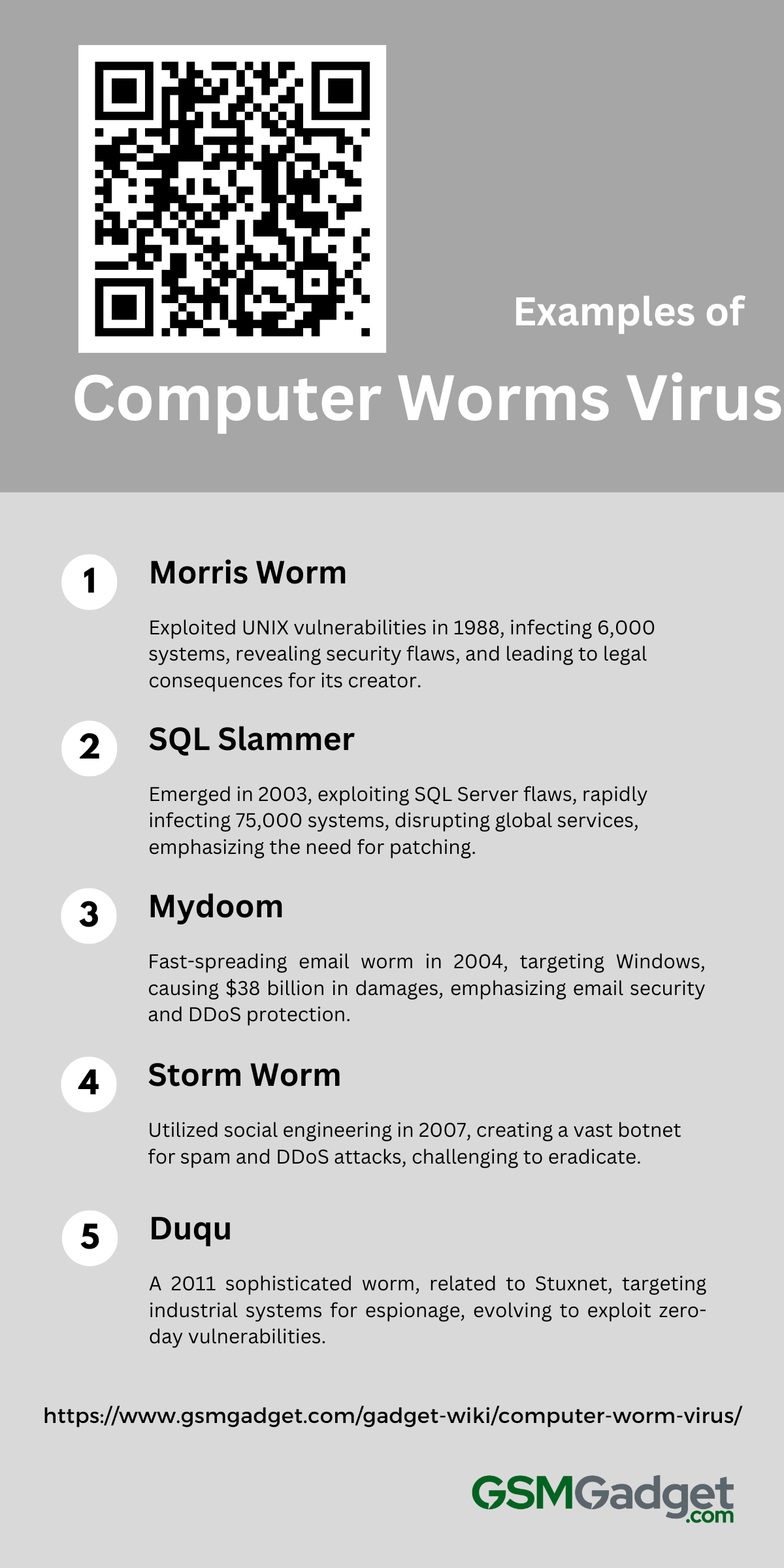
1. Morris
The Morris Worm, created by Robert Tappan Morris and released on November 2, 1988, is a significant event in the history of computer security. It is one of the earliest computer worms to receive widespread media attention. The worm exploited vulnerabilities in UNIX systems, specifically the fingerd network service, as well as buffer overflows and the rsh/rexec commands, to spread across networks without requiring user passwords. Due to its flawed replication mechanism, the worm infected the same systems multiple times, leading to a drain on system resources and causing significant slowdowns or crashes. The Morris Worm infected approximately 6,000 computers, which accounted for around 10% of the internet-connected machines at that time. This disruption highlighted the need for improved network security measures. The incident resulted in the first conviction under the Computer Fraud and Abuse Act, with Morris receiving a sentence of community service and a fine. This event serves as a cautionary tale about the potential unintended consequences of seemingly harmless code in the digital realm.
2. SQL Slammer
The SQL Slammer worm, also known as Sapphire, emerged as a significant computer worm virus in January 2003 by exploiting a buffer overflow vulnerability in Microsoft’s SQL Server and Desktop Engine database products. Its capability to quickly replicate without writing to disk enabled it to infect approximately 75,000 systems within 10 minutes, doubling its victim count every few seconds and causing significant disruptions to global internet traffic, financial systems, airline operations, and emergency services. The memory-resident nature of SQL Slammer made detection and removal challenging, emphasizing the critical importance of timely software updates and robust security protocols to mitigate cyber threats of this nature.
3. Mydoom
Mydoom, also known by various aliases such as W32.MyDoom@mm, Novarg, Mimail.R, and Shimgapi, first appeared in January 2004 and quickly became one of the fastest-spreading email worms in history, specifically targeting Microsoft Windows systems. It spread by sending deceptive emails with attachments that, when opened, would execute its malicious payload. This allowed Mydoom to replicate itself by sending emails to contacts from the victim’s address book, as well as installing a backdoor for unauthorized remote access. This turned infected computers into bots for coordinated Distributed Denial of Service (DDoS) attacks, including a significant one against Google. The impact of Mydoom was significant, with estimated damages exceeding $38 billion, underscoring the critical importance of robust cybersecurity practices to mitigate the risks associated with email attachments and safeguard system integrity and internet functionality.
4. Storm Worm
First identified in 2007, the Storm Worm is a well-known computer worm that propagated through emails containing misleading subject lines, such as “230 dead as storm batters Europe,” utilizing social engineering to deceive users into clicking on harmful attachments or links. This process converted the compromised computers into a large botnet capable of executing synchronized attacks, including sending spam and distributed denial-of-service (DDoS) attacks. The worm exhibited high resilience, employing advanced evasion tactics to evade detection and proving challenging to eradicate from infected systems. At its peak, the Storm Worm’s botnet comprised millions of ‘zombie’ computers, underscoring the crucial importance of cybersecurity awareness and robust protective measures to combat such sophisticated and harmful threats.
5. Duqu
Discovered in 2011, Duqu is a sophisticated computer worm virus with cyber-espionage capabilities. It shares a significant amount of its code with the Stuxnet worm, suggesting it may have been developed by the same cyber attackers. Duqu infiltrates industrial control systems through zero-day vulnerabilities to gather intelligence, log keystrokes, and steal digital certificates. It operates stealthily by residing only in memory, leaving no traces on disk. Duqu communicates with command and control servers using encrypted dummy and image files, making its detection and analysis more difficult. Duqu has evolved to keep up with the cybersecurity arms race, with its 2015 version, Duqu 2.0, exploiting multiple zero-day vulnerabilities and targeting major global events. This adaptability highlights Duqu’s ongoing threat to national security and critical infrastructure, requiring advanced security measures to mitigate its risks.
Symptoms of Computer Worm Virus Infection
Symptoms of a computer worm infection can vary, but there are several common indicators that may suggest your computer has been compromised. Here are the typical symptoms you should be aware of:
- Unexpected Computer Activity: Your computer may display odd messages, sounds, or images, signaling potential infection.
- Programs Launching on Their Own: Be wary if applications start spontaneously, without your command.
- Reduced System Performance: A computer worm can cause a noticeable slowdown by consuming system resources.
- Frequent Crashes and Freezes: Regular occurrences of your system crashing or freezing might indicate a worm’s presence.
- Security Alerts and File Changes: Watch for unexplained firewall warnings, unsolicited emails sent from your account, alterations in file integrity, and the appearance of unfamiliar icons on your desktop.
Techniques for detecting Computer Worm Virus
In the constantly changing field of cybersecurity, it is essential to stay ahead of threats. Computer worm viruses are especially harmful, as they can replicate themselves and spread rapidly across networks. In the following section, we describe a set of effective techniques aimed at detecting and eliminating these covert digital attackers before they can compromise system security.
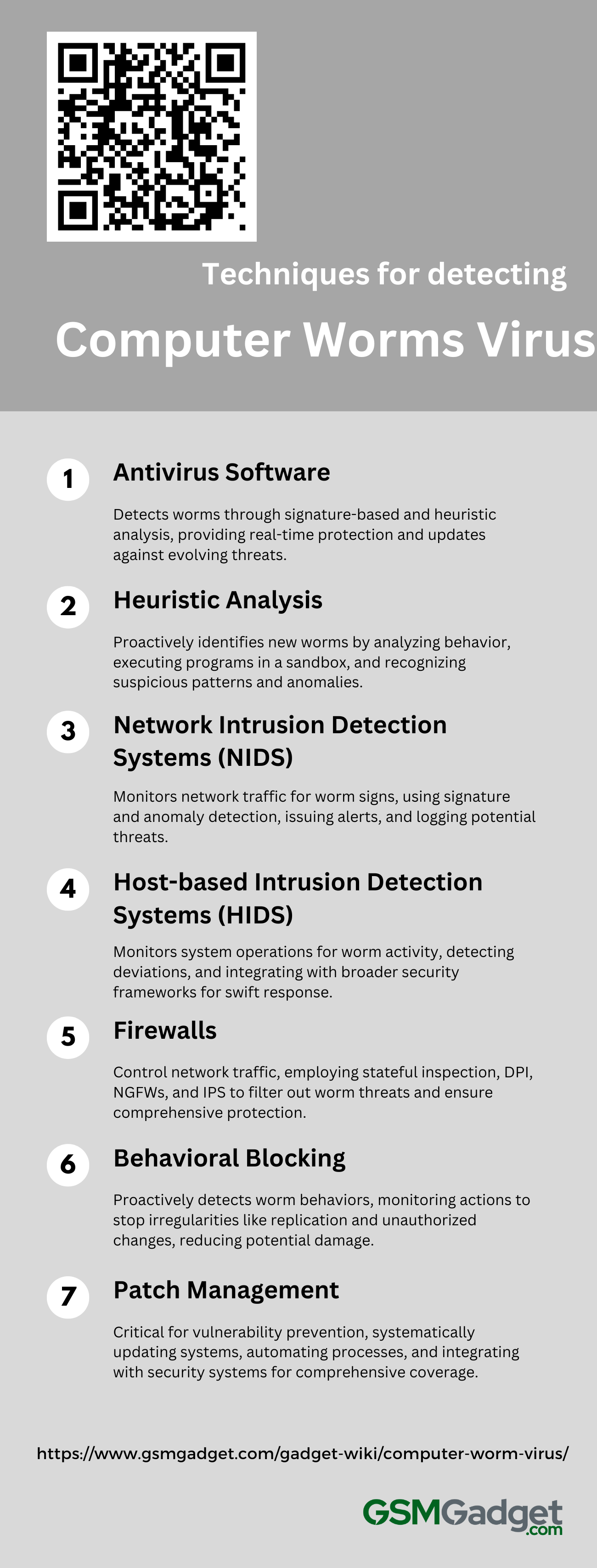
1. Antivirus Software
Antivirus software is a crucial component of cybersecurity, created to defend against computer worm viruses using a mix of signature-based, heuristic, and behavior-based detection methods. These programs search for recognized worm signatures and observe system behavior to detect irregularities like unauthorized replication or suspicious network activity, which could suggest a worm infection. Heuristic analysis improves protection by identifying new, unidentified worms based on code attributes. By providing real-time protection to intercept suspicious activities and receiving regular updates to remain up-to-date with the most recent worm definitions, antivirus software provides a thorough defense against the constantly changing threats presented by computer worms in the ever-evolving digital environment.
2. Heuristic Analysis
Heuristic analysis is an advanced technique in the field of cybersecurity that is essential for detecting new and unknown computer worms and viruses. It differs from traditional signature-based detection methods by utilizing algorithmic strategies to analyze software behaviors for indications of malicious activity. This proactive approach involves executing programs in a secure virtual sandbox to monitor their actions, such as replication, file overwriting, and unauthorized system access, without compromising the actual system. By examining code structures and utilizing models based on known malware characteristics, heuristic analysis can identify suspicious patterns and anomalies. This dynamic method allows for the anticipation and prevention of potential threats, ensuring a strong defense against the constantly evolving landscape of cyber threats.
3. Network Intrusion Detection Systems (NIDS)
Network Intrusion Detection Systems (NIDS) are essential components in the field of cybersecurity, responsible for identifying computer worm viruses by monitoring network traffic for signs of compromise. These systems analyze data packets for abnormalities or matches to known malware signatures, using both signature-based and anomaly-based detection techniques. Signature-based detection accurately identifies known threats by comparing network traffic to a database of known worm signatures, while anomaly-based detection detects deviations from normal behavior, identifying potentially new or unrecognized worms. Advanced NIDS may also use heuristic analysis to identify unfamiliar worms by recognizing behaviors typical of worm spread, such as rapid file distribution. By issuing real-time alerts and logging potential threats, NIDS provide IT professionals with the tools to quickly address and eliminate worm infections, protecting the integrity and continuity of network operations.
4. Host-based Intrusion Detection Systems (HIDS)
Host-based Intrusion Detection Systems (HIDS) are a crucial element of cybersecurity measures, providing strong protection against computer worm viruses by monitoring the internal operations of a system. These systems analyze system logs, file integrity, and network traffic to detect deviations from normal behavior that may indicate an infection. By utilizing heuristic and signature-based detection techniques, HIDS can identify known worm patterns as well as unusual activities that suggest a worm infiltration. Operating at the host level, they provide an important layer of defense, particularly against worms that can bypass network defenses and spread rapidly across networks. Integration of HIDS with broader security frameworks enables real-time alerts and swift incident response, ensuring that threats are promptly contained and neutralized to safeguard the integrity and confidentiality of the host system.
5. Firewalls
Firewalls are a critical component in the cybersecurity arsenal, offering a robust line of defense against computer worm viruses through meticulous monitoring and control of network traffic. These security gatekeepers enforce predetermined rules to analyze and filter incoming and outgoing data, rejecting any packets that fail to comply with established security standards. Advanced firewalls leverage techniques like stateful inspection to monitor active connections contextually and deep packet inspection (DPI) to probe the content within packets for hidden worms. Next-generation firewalls (NGFWs) further enhance protection by examining packet payloads for malicious signatures, while some are fortified with intrusion prevention systems (IPS) that proactively identify and neutralize threats, ensuring a comprehensive shield against the infiltration and spread of computer worm viruses.
6. Behavioral Blocking
Behavioral blocking is an advanced cybersecurity defense mechanism that proactively identifies and counters computer worm viruses through real-time monitoring of software behaviors. This approach goes beyond the traditional signature-based detection used by antivirus tools, instead focusing on program actions to detect irregularities that may indicate a worm infection. These irregularities include unusual file replication, unauthorized network connections, and unauthorized changes to system settings. By establishing normal patterns for software operations, behavioral blocking can detect and stop suspicious activities early on, often before worms are able to carry out their malicious actions or spread to other systems. Tools like Microsoft Defender for Endpoint utilize behavioral blocking to analyze and control process behaviors, effectively preventing ongoing attacks. This method is crucial for early detection and containment of worms, ultimately reducing the potential damage they can cause within a network.
7. Patch Management
Patch management is a crucial cybersecurity strategy for defending against computer worm viruses. It involves systematically notifying, identifying, and installing software and system updates released by vendors to address security vulnerabilities. Failure to patch these vulnerabilities could leave systems open to exploitation by worms. Organizations can reduce the risk of worm infiltration and spread by keeping their systems up to date with the latest patches, automating the update process, and prioritizing patches based on vulnerability severity. Maintaining a comprehensive inventory of IT assets is essential to ensure complete coverage, and integrating patch management tools with security systems enhances detection and response capabilities. This integration provides alerts for unpatched vulnerabilities and continuous monitoring to protect all network endpoints from worm attacks.
Prevention and Mitigation Strategies of Computer Worm Virus
Computer worms present a substantial risk to digital security by quickly reproducing and infiltrating networks without user involvement. It is essential to comprehend and execute efficient prevention and mitigation tactics to protect against these harmful entities. The following are the essential measures to contemplate for strong defense against computer worm viruses.
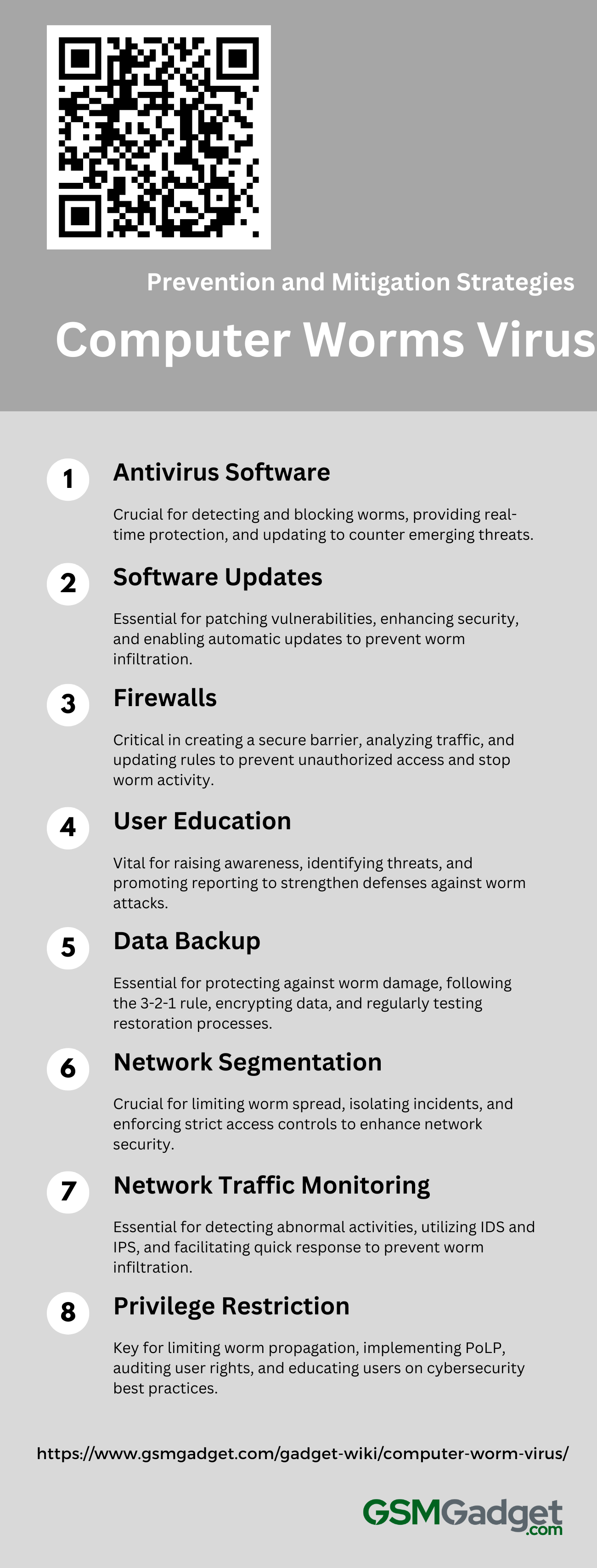
1. Use Antivirus Software
In the field of cybersecurity, robust antivirus software is essential for preventing and mitigating computer worm viruses. These malicious programs, capable of autonomous replication and network dissemination, pose a serious threat to system and data integrity. Antivirus solutions are designed to proactively scan for and detect both known and emerging threats through signature-based and heuristic analysis, effectively preventing initial infections. They provide real-time protection by continuously monitoring system activities, quarantining suspicious files, and delivering updates to keep pace with the constantly changing virus landscape. Features such as firewalls and email scanning are also included to intercept malicious traffic and phishing attempts. To ensure comprehensive security, it is vital to regularly update antivirus programs to guard against the latest worm variants and prevent potential system vulnerabilities.
2. Apply Software Updates
In the field of cybersecurity, a key tactic for staying ahead of computer worm viruses is the consistent application of software updates. These updates frequently include vital patches that rectify security loopholes, which, if neglected, could allow worms to breach and propagate within networks. Keeping both operating systems and applications current closes off these vulnerabilities, hindering worm access. Continuous enhancements in security features by software developers, coupled with enabling automatic updates, offer prompt defense against emerging threats. Moreover, up-to-date software can boost system efficiency and compatibility, reinforcing the digital infrastructure’s defense against these insidious threats. Thus, integrating these updates into regular cybersecurity practices is crucial for robust protection in the dynamic domain of cyber threats.
3. Implement Firewalls
In the field of cybersecurity, firewalls are crucial for preventing and controlling the spread of computer worm viruses. They serve as a critical defense mechanism by creating a secure barrier between trusted internal networks and potentially harmful external networks, such as the internet. Firewalls analyze network traffic, utilizing a set of rules to allow legitimate communication and block unauthorized access. This helps prevent worms from exploiting vulnerabilities like open ports or unpatched services. It is essential to configure firewalls to identify and stop suspicious patterns that indicate worm activity. Next-generation firewalls enhance protection through deep packet inspection, intrusion prevention systems, and application awareness. Regular updates to firewall rules are necessary to stay ahead of evolving threats, ensuring proactive and strong security measures for organizations and individuals to safeguard their digital assets.
4. Educate Users
In the field of cybersecurity, educating users is a crucial strategy for preventing and mitigating computer worm viruses. By increasing awareness of the risks associated with suspicious emails, unknown links, and downloads from untrusted sources, users are better able to avoid potential threats. Regular training sessions that highlight the identification of these risks, along with the importance of keeping antivirus software updated and using strong, unique passwords, can significantly reduce the chances of an infection. Organizations can also improve their defense mechanisms by conducting simulated phishing exercises to evaluate and enhance user awareness. Promoting a culture of reporting suspected security threats allows for quick action to address and resolve any issues, thus preserving the integrity of individual systems and the overall network infrastructure. Through continuous education, users play a critical role in strengthening their organization’s cybersecurity defenses.
5. Backup Data
In the field of information technology, protecting data from computer worm viruses is crucial, and a strong backup strategy is essential for effective prevention and mitigation. Using automated backup solutions that regularly save and store data on-site and off-site, including multiple historical versions, allows for comprehensive recovery options. Following the 3-2-1 backup rule – having three copies of data on two different types of media, with one stored offsite – provides redundancy and enhances data security. Encrypting backup data adds an extra layer of protection against unauthorized access, while regularly testing backup integrity and restoration processes ensures that systems can be quickly and efficiently restored in the event of a worm attack, maintaining business continuity and minimizing downtime.
6. Network Segmentation
Network segmentation is a crucial defense mechanism in preventing the spread of computer worm viruses. By dividing a network into smaller, controlled subnets with specific security measures, it is possible to limit a worm’s ability to move sideways and infect the entire system. This approach not only isolates incidents to reduce damage, but also helps in quickly identifying and containing threats. The use of strict access controls and traffic management policies, such as firewalls and intrusion detection systems, further enhances network security. These measures ensure that only authorized users and services can access the network, reducing the potential for attacks and strengthening the network’s overall resistance to cyber threats.
7. Monitor Network Traffic
In the field of cybersecurity, monitoring network traffic vigilantly is a crucial strategy for preventing and mitigating computer worm viruses. IT professionals use real-time traffic analysis tools and intrusion detection systems (IDS) to detect and respond to abnormal activities, such as sudden increases in bandwidth or unusual outbound communications that indicate worm infiltration. These systems, in conjunction with intrusion prevention systems (IPS), are skilled at identifying the signatures of known worms, allowing for immediate blocking or quarantining of malicious payloads. Thorough logging of network activity also facilitates quick post-incident analysis, enabling prompt isolation of compromised systems to stop the virus from spreading. By proactively employing these advanced network security measures, organizations can effectively protect their digital infrastructure from the threats posed by computer worms.
8. Restrict Privileges
In the field of cybersecurity, a crucial measure for preventing and mitigating computer worm viruses is the careful restriction of user privileges. By consistently implementing the principle of least privilege (PoLP), users and programs are only given the necessary access rights for their roles, reducing the potential for attacks and limiting the worm’s ability to spread or carry out harmful activities. Strict control over administrative privileges is especially important, as these can enable worms to replicate and move through networks. To prevent privilege escalation and maintain a strong security posture, it is essential to regularly audit and adjust user rights. The use of role-based access control (RBAC) improves this process by aligning access with specific organizational roles. Additionally, educating users on cybersecurity best practices enhances the effectiveness of these strategies, creating a more resilient computing environment.
